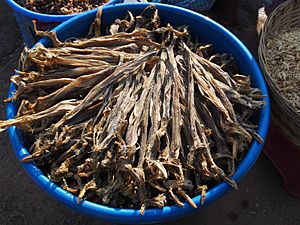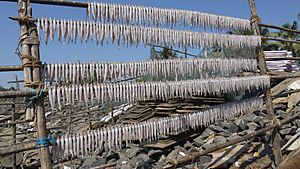Bombay duck facts for kids
Quick facts for kids Bombay duck |
|
|---|---|
 |
|
| Conservation status | |
| Scientific classification | |
| Genus: |
Harpadon
|
| Species: |
nehereus
|
The Harpadon nehereus, often called the Bombay duck, is a type of lizardfish. It has many other names like bummalo, bombil, boomla, lote, and loitta. Adult Bombay ducks can grow up to 40 centimeters (about 16 inches) long. However, they are usually around 25 centimeters (about 10 inches) long.
What's in a Name? The Story of Bombay Duck
The name "Bombay duck" has an interesting history. Long ago, this fish was often thrown away in Bombay (now Mumbai). But in Bengal, it was seen as a special food.
When railways started in India, this fish was sent from Bombay to Calcutta (now Kolkata). It traveled on mail trains. Because of this, people started calling it "Bombay Mail fish" or "Bombay Daak." "Daak" means "mail" in Bengali. Some people say a British official gave it this name. He disliked the strong smell of the fish on the train, comparing it to the smell of mail from Bombay.
Local stories in Bangladesh say that Robert Clive, a British leader, first used the term "Bombay duck." He tasted the fish during his time in Bengal. He supposedly linked its strong smell to the newspapers and mail arriving from Bombay. Later, the name became popular in British restaurants that served Indian food. The name "Bombay duck" was even used in books as early as 1815.
Where Does Bombay Duck Live and How Is It Caught?
The Bombay duck lives in warm, tropical parts of the Indo-Pacific ocean. This includes areas like the Laccadive Sea near Maharashtra and Gujarat in India. It is a very important fish for people living there. You can also find this fish in the Bay of Bengal and the South China Sea, though in smaller numbers.
People often eat the Bombay duck fresh, especially fried or in a curry. It is also dried, or dried and salted. When dried, the fish has a very strong smell. Because of this, it is usually carried in special airtight containers. Dried Bombay duck is a popular food in parts of India, especially Maharashtra. In Sri Lanka, people eat it dried, either fried or cooked in a curry.
How Bombay Duck Became Available Worldwide

Years ago, people in the UK ate about 13 tons of Bombay duck every year. But in 1996, something changed. Some imported seafood was found to have harmful bacteria called Salmonella. Because of this, the European Commission (EC) stopped all fish imports from India. Only fish from approved freezing and canning factories were allowed.
Since Bombay duck is dried in the open air and not in a factory, this rule accidentally banned it. People started a campaign called "Save Bombay Duck." The Indian High Commission talked to the EC about the ban. The EC then changed its rules. Now, Bombay duck can still be dried in the open air. But it must be packed in a special "EC approved" packing station.
A wholesale merchant in Birmingham, UK, found a packing station in Mumbai. After that, Bombay duck became available in the UK again!
You can also find fresh Bombay duck in Canadian cities with many Indian people, like Toronto and Montreal. There, it is often called bumla. While it's most popular with people from certain parts of India, Sri Lanka, and Bangladesh, more and more people from other South Asian countries are starting to enjoy it too.



